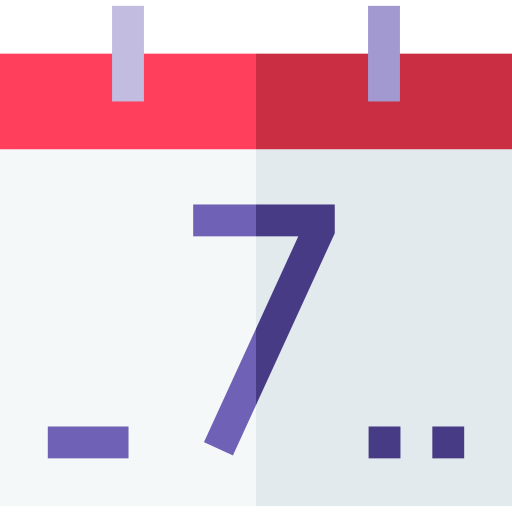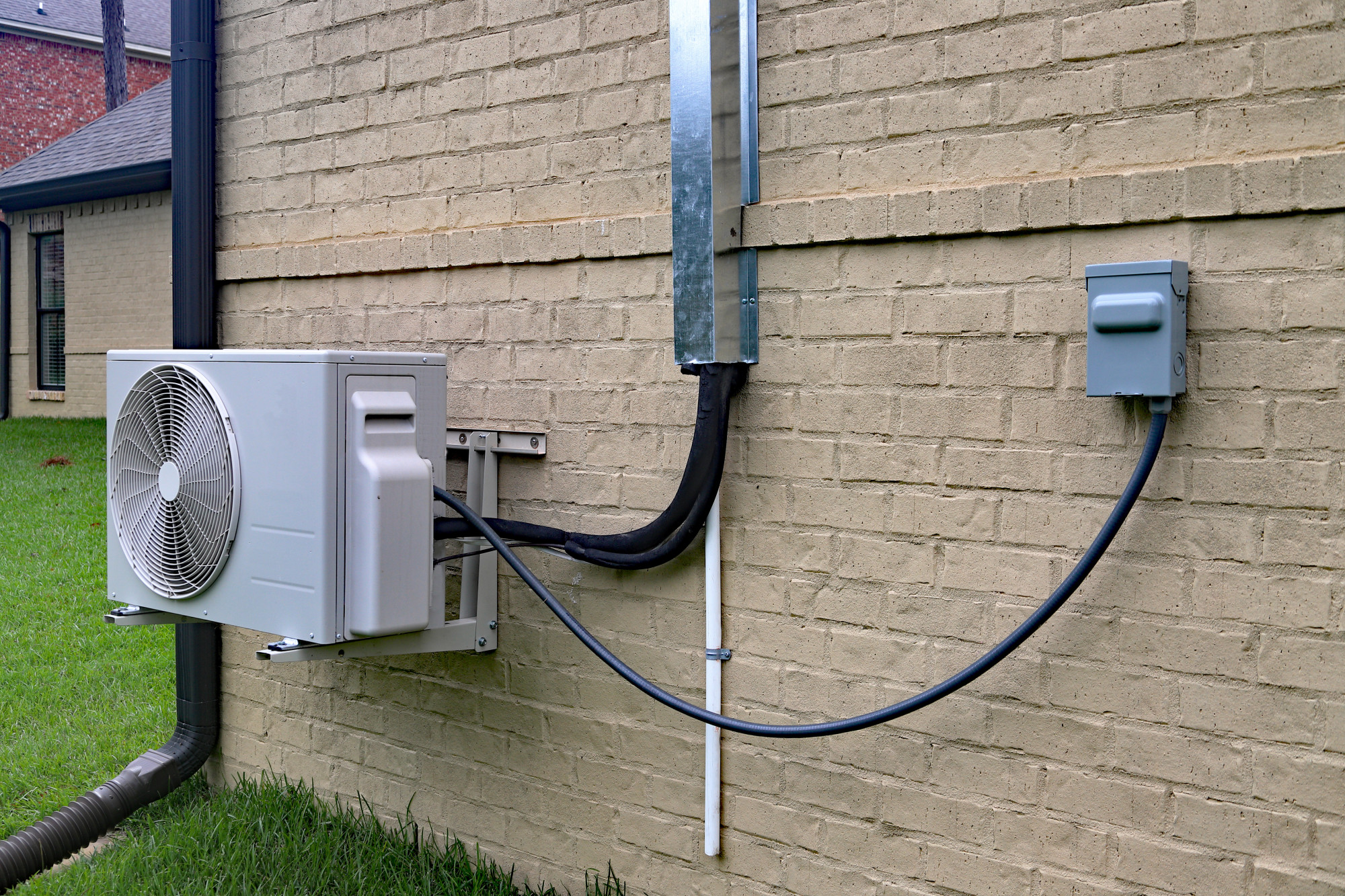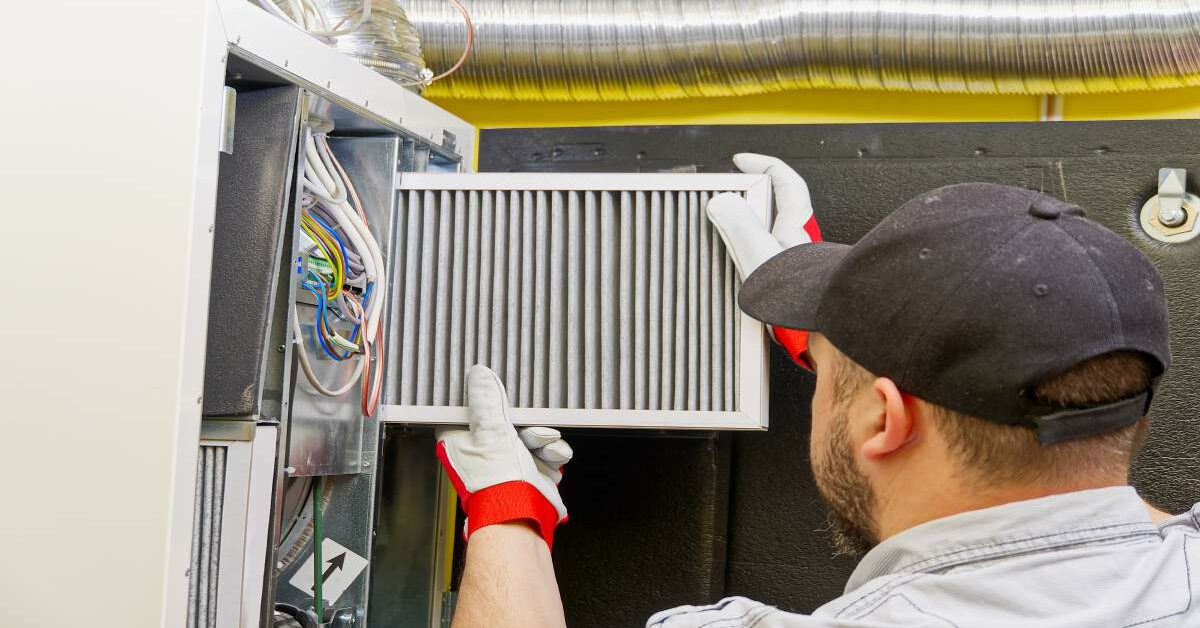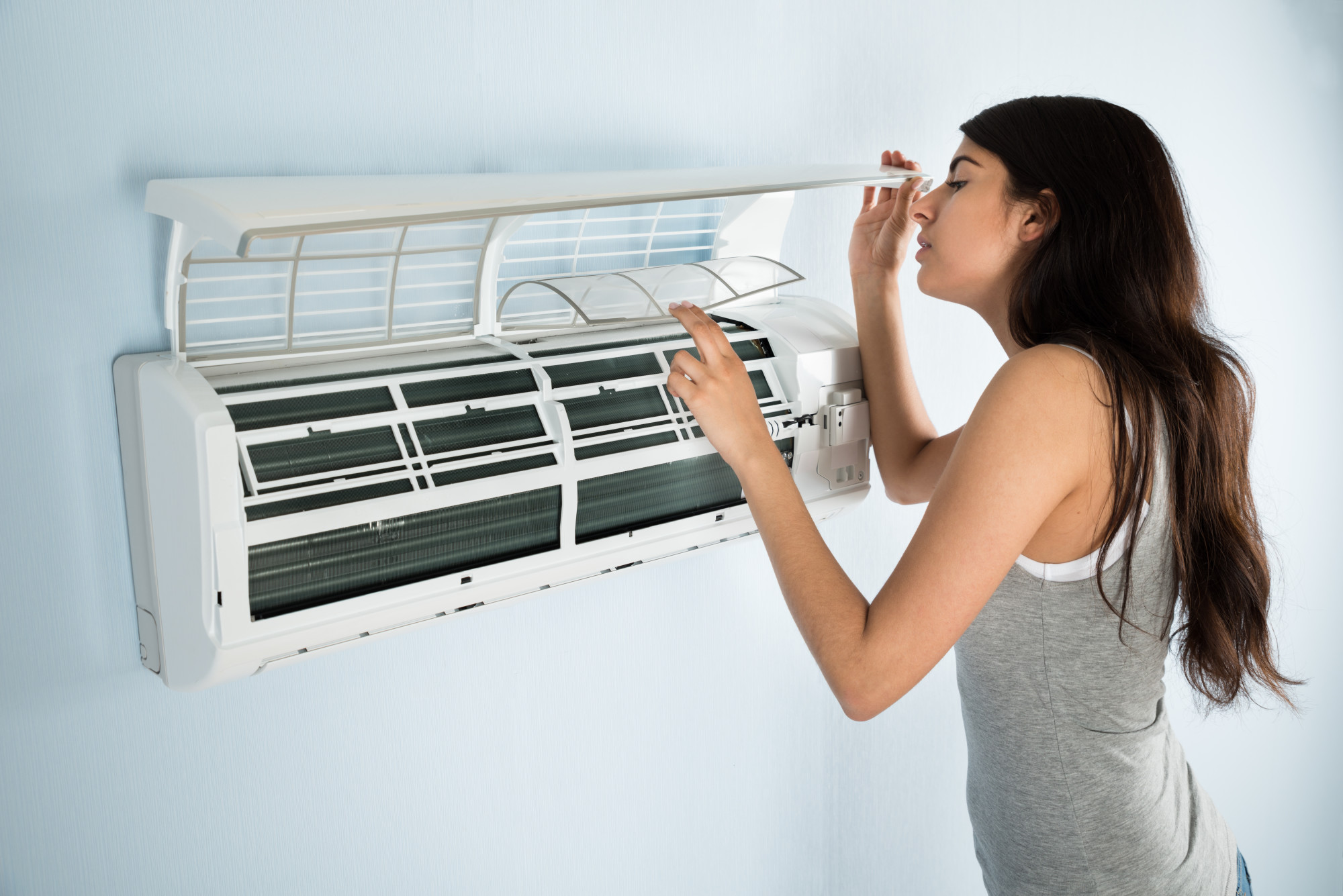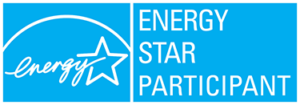Ever wonder how much it costs to run your air conditioner? Many people turn on the AC without considering its effect on their bills.
Natural Resources Canada states that space cooling comprised about 2% of residential energy use in 2018. That may not sound like a lot, but for a lower-income household, even a small bump in the bill can be a big deal.
This is comparatively little compared to average heating costs across most of Canada, but that proportion is rising.
In this article, we’ll explain what running your AC costs. We’ll look at real examples and show you how to estimate your costs with a simple calculator. We will also walk through what makes your AC more or less expensive to run.
How Much Does AC Cost Per Month?

Running a central air conditioner can bump your energy bill by around $50 to $250 monthly during the hot summer stretch. That number depends on how often you use it, your home’s size, and other factors.
Your AC will pull about 1,000 watts per ton of cooling. So if you’ve got a 3.5-ton unit (which is pretty standard for a 2,000-square-foot house), you’re looking at about 3,500 watts an hour.
Most central AC units use 3,000 to 4,000 watts every hour they run. Ductless mini-spilts generally consume between 500 and 1,500 watts per hour, but typically cool only certain rooms rather than a whole home.
Newer models with higher efficiency ratings use less power to do the job. If your unit has a SEER rating (Seasonal Energy Efficiency Ratio) of 16 or more, it’ll cost you less to run than an older, lower-rated system. Higher SEER = lower bills.
Air Conditioner Operating Cost Calculator
To calculate how much your AC costs to run, all you need to know is:
- How many watts your air conditioner uses
- How many hours a day it runs
- Your electricity rate (in cents per kilowatt-hour or kWh)
Formula for Determining AC Costs to Operate
AC Operating Cost = (Wattage ÷ 1,000) × Hours Used × Electricity Rate
If your AC uses 4,000 watts, runs for 8 hours, and your rate is $0.15 per kWh:
(4,000 ÷ 1,000) × 8 × 0.15 = $4.80 per day
Over 30 days, that’s $144 a month. You can plug in your numbers to see what your setup costs.
If you want a more accurate number, consider using a smart plug or energy monitor to track your AC’s real usage over a few days. Then, plug that into the formula.
You can also use our Free Air Conditioner Cost Calculator.
AC Cost Factors
Two people can run the same air conditioner for the same amount of time and still have very different hydro bills.
Here’s a look at what really drives your cooling costs:
Local Electricity Costs
Electricity rates aren’t the same across Canada. The same air conditioner that costs $3 daily to run in Manitoba might cost $5 in Ontario. If you’re in a province with high rates, you will feel it on your bill.
Depending on the province or territory, electricity rates may vary based on time-of-use (TOU) pricing, tiered rates, or fixed rates.
Obviously some areas like Northern Canadian territories and regions, don’t typically use air conditioning as much. Although many regions like BC, where air conditioners weren’t as common, have been seeing an increase in adoption in recent years following major heat waves, like the 2021 heat dome which lead to many deaths.
The increase in heat pumps which can also operate as an air conditioner, is also leading to a rise in household spending on cooling.
Here’s the average monthly electricity cost by province, based on using 1,000 kWh:
| Alberta | 25.8¢/kWh |
|---|---|
| British Columbia | 11.4¢/kWh |
| Manitoba | 10.2¢/kWh |
| New Brunswick | 13.9¢/kWh |
| Newfoundland & Labrador | 14.8¢/kWh |
| Nova Scotia | 18.3¢/kWh |
| Northwest Territories | 41.0¢/kWh |
| Nunavut | 35.4¢/kWh |
| Ontario | 14.1¢/kWh |
| Prince Edward Island | 18.4¢/kWh |
| Quebec | 7.8¢/kWh |
| Saskatchewan | 19.9¢/kWh |
| Yukon Territory | 18.7¢/kWh |
| Canada Average | 19.2¢/kWh |
Source: Energy Hub
AC Energy Efficiency
A higher-efficiency AC unit can save you thousands over its lifetime.
Take a look at the chart above. It shows different air conditioners’ life cycle operating costs based on their SEER rating. This is based on a 3-ton unit running for 2,100 cooling hours at $0.11 per kWh.
- A unit with a SEER of 8 could cost around $13,500 over its lifespan.
- A SEER 16 unit brings that down to around $7,500.
- Go up to SEER 23, and you’re looking at less than $5,000 in total electricity costs.
Thermostat Settings
The lower you set your thermostat, the harder your air conditioner has to work. That means more electricity, longer run times, and higher costs.
According to the U.S. Department of Energy, lowering your thermostat by 7 to 10°F (about 4 to 6°C) for 8 hours a day can save you up to 10% yearly on heating and cooling costs. That’s a pretty easy win, especially if you’re out during the day or asleep at night.
If you’re not already using a programmable or smart thermostat, it might be time to look into one. Set it to cool your home only when you actually need it.
Outdoor Conditions
One study found that when outdoor temperatures increased by 20°F, the AC’s compressor used 25% more power, while total cooling capacity dropped by 13%. On top of that, the Energy Efficiency Ratio (EER)—which measures how well your AC turns electricity into cool air—fell by 28%.
Translation? You’re paying more for less cooling.
It gets even trickier in cities. The Urban Heat Island (UHI) effect means urban areas are hotter than the countryside. Concrete, asphalt, and buildings soak up heat all day and slowly release it, keeping city temperatures higher—especially at night. That puts even more strain on your AC, leading to longer run times and higher bills.
AC Installation, Maintenance, and Ducts
Even if you’ve got a top-of-the-line, high-efficiency air conditioner, it won’t perform well if it’s not installed or maintained properly. In fact, improper installation can cut your AC’s efficiency by up to 30%.
And don’t forget about your ducts. In a typical home, 20% to 30% of the air moving through the ductwork is lost through leaks, holes, or bad connections. That’s cool air leaking into your attic or basement instead of your living room.
Consider having your ducts sealed by a professional, which can help reduce your heating and cooling bills.
Size of Home
The bigger your home, the more space your AC has to cool—and the more energy it will use. A small condo with one or two rooms doesn’t need nearly as much power as a 2,500-square-foot house.
But it’s not just about square footage. Ceiling height, layout, insulation, and the number of windows also matter.
That’s why getting an expert to properly size your unit when buying a new air conditioner is essential.
How Much Does It Cost to Run an AC for an Hour?
Let’s talk hourly costs because sometimes you just want to know what flipping on the AC for a bit is going to cost you.
- A typical central AC uses about 3.5 kW. At Ontario’s average electricity rate of $0.169/kWh, it costs: 3.5 × $0.169 = $0.59 per hour.
- A mini-split system uses around 1.2 kW. Using the same rate: 1.2 × $0.169 = $0.20 per hour
Nighttime vs. Daytime AC Usage: Which Is More Expensive?
The time you use your AC can be just as important as how long you use it.
Take Ontario as an example. Under the Time-of-Use (TOU) pricing system, electricity rates are cheaper at night and more expensive during the day—especially in the afternoon when demand is highest.
From May to October (summer schedule), here’s how the rates break down:
- Off-Peak (7 p.m. – 7 a.m.): 8.7¢/kWh
- Mid-Peak (7–11 a.m. & 5–7 p.m.): 12.2¢/kWh
- On-Peak (11 a.m. – 5 p.m.): 18.2¢/kWh
So if you’re running your AC during the hottest part of the day—like early afternoon—it can cost more than twice as much as running it overnight.
And that’s just Ontario. Other provinces have different billing systems. Some use tiered pricing, while others offer flat rates, seasonal pricing, or ultra-low overnight plans.
How Much Does It Cost to Run AC All Day?
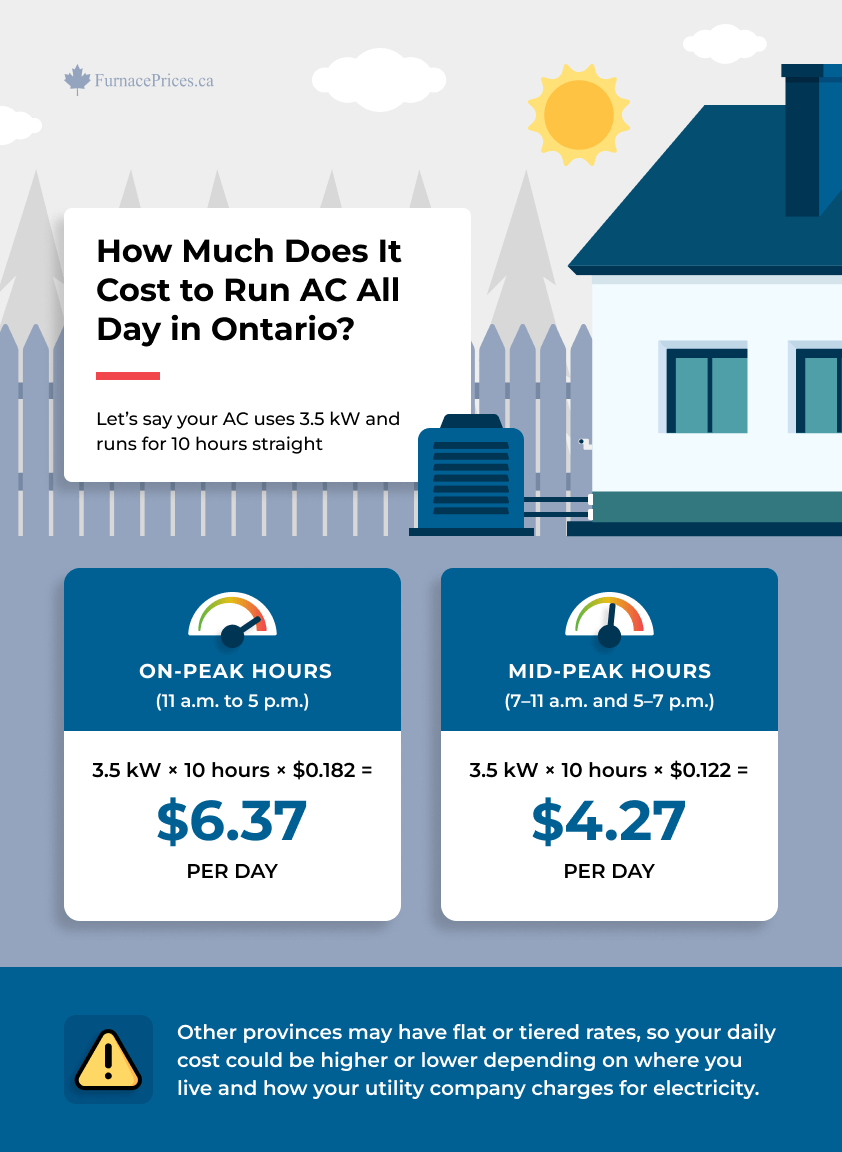
If you’re in Ontario and running your central AC during peak summer hours, here’s what it could cost using the Time-of-Use (TOU) rates.
Let’s say your AC uses 3.5 kW and runs for 10 hours straight during on-peak hours (11 a.m. to 5 p.m.):
- 3.5 kW × 10 hours × $0.182 = $6.37 per day
If it runs for 10 hours during mid-peak hours (7–11 a.m. and 5–7 p.m.):
- 3.5 kW × 10 hours × $0.122 = $4.27 per day
Other provinces may have flat or tiered rates, so your daily cost could be higher or lower depending on where you live and how your utility company charges for electricity.
How Much Does It Cost to Run an AC All Night?
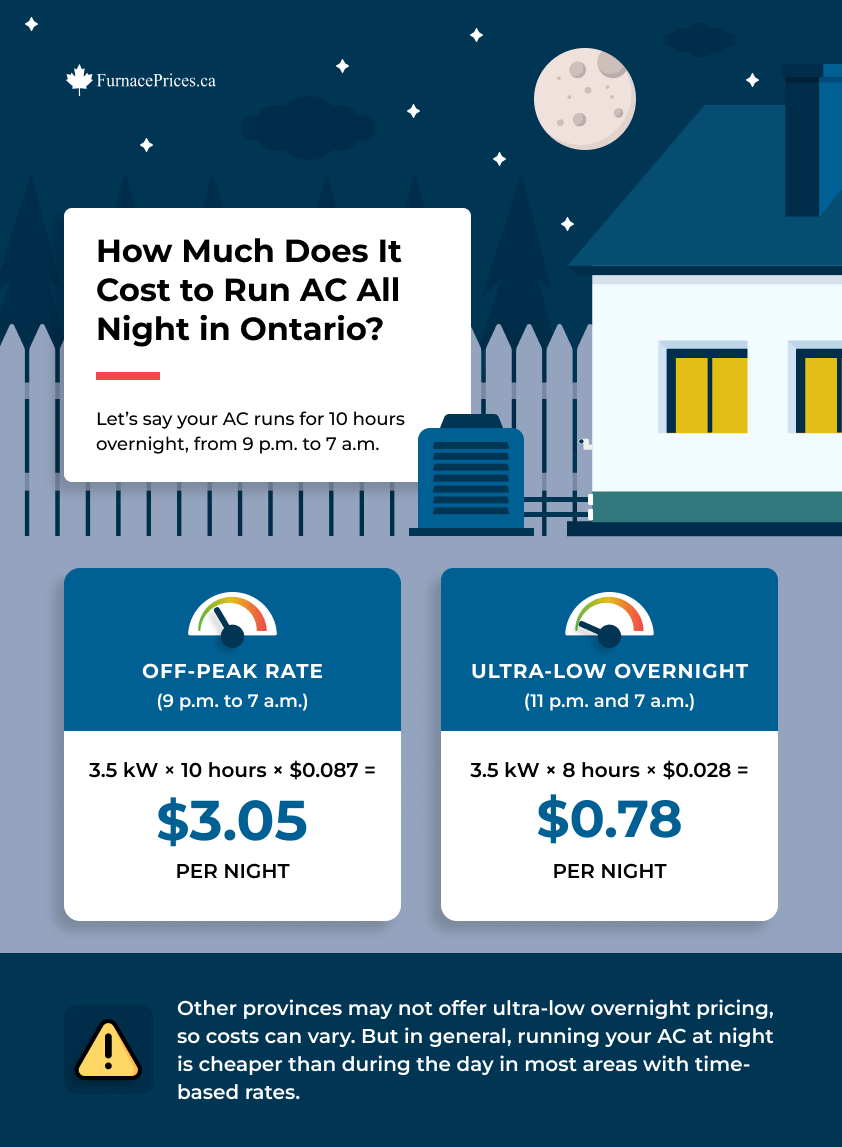
Let’s say your AC runs for 10 hours overnight, from 9 p.m. to 7 a.m. in Ontario. These hours fall under the off-peak period, where electricity is cheapest.
Using the off-peak rate of $0.087/kWh and a central AC that uses 3.5 kW:
- 3.5 kW × 10 hours × $0.087 = $3.05 per night
If you’re on the Ultra-Low Overnight (ULO) plan and run your AC between 11 p.m. and 7 a.m., the rate drops to $0.028/kWh:
- 3.5 kW × 8 hours × $0.028 = $0.78 per night
Other provinces may not offer ultra-low overnight pricing, so costs can vary. But in general, running your AC at night is cheaper than during the day in most areas with time-based rates.
Cost to Run 5000 to 18000 BTU Air Conditioner
Here’s a quick look at how much it costs to run different sizes of window or portable air conditioners based on their cooling capacity in BTUs.
| AC Size (BTU) | Power Use (Watts) | Cost per Hour ($) |
|---|---|---|
| 5,000 BTU | Rs500 | $0.10 |
| 6,000 BTU | Rs600 | $0.12 |
| 8,000 BTU | Rs800 | $0.15 |
| 10,000 BTU | Rs1,000 | $0.19 |
| 12,000 BTU | Rs1,200 | $0.23 |
| 14,000 BTU | Rs1,400 | $0.27 |
| 15,000 BTU | Rs1,500 | $0.29 |
| 18,000 BTU | Rs1,800 | $0.35 |
These numbers are based on the national average electricity rate of $0.192 per kWh.
Cost Comparison: Window vs. Portable vs. Mini-Split vs. Central AC
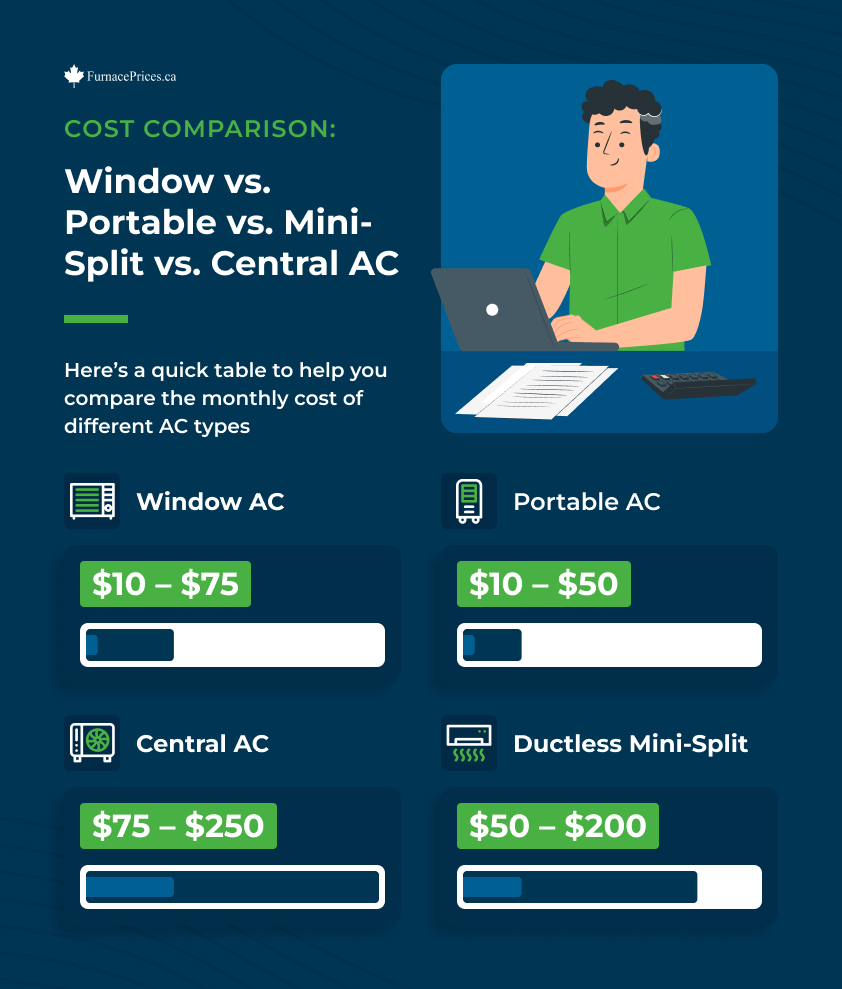
Here’s a quick table to help you compare the price, power, and monthly cost of different AC types, like window units, portable ACs, mini-splits, and central air systems:
| AC Type | Price Range | Avg. Monthly Cost | Cooling Capacity (BTU) | Best For |
|---|---|---|---|---|
| Window AC | $175 – $800 | $10 – $75 | 5,000 – 25,000 | Small to medium rooms |
| Portable AC | $300 – $700 | $10 – $50 | 5,000 – 15,000 | Rooms without window access |
| Central AC | $3,500 – $7,000 | $75 – $250 | 12,000 – 60,000 (1–5 tons) | Whole-home cooling (with ductwork) |
| Ductless Mini-Split | $4,000 – $8,000+ | $50 – $200 | 12,000 – 60,000 (1–5 tons) | Zoned cooling or homes without ducts |
Price ranges include average costs across Canada and may vary by brand, features, and installation requirements.
How to Save Money on Air Conditioner Costs
Here are some easy, practical ways to save AC costs to some extent:
- Clean or replace air filters every 1–3 months: Dirty filters block airflow, which makes your AC work harder and use more power. Clean filters = smoother airflow and lower energy use.
- Avoid using heat-producing appliances daily: Ovens, stoves, and dryers pump extra heat into your home. Stick to cooler options like the microwave, slow cooker, or BBQ—especially in the afternoon.
- Use blinds or curtains during the day: Keep the sun out by closing blinds or curtains. It helps stop heat from building up inside.
- Take shorter, cooler showers: Long, hot showers create steam that warms up the house. Switch to quick, cool showers to reduce humidity and help your AC do less work.
- Use ceiling fans to boost airflow: Fans help circulate cool air, so your AC doesn’t have to run as long.
Frequently Asked Questions
Does leaving the AC on all day cost more than turning it on and off?
It depends. If you’re leaving it on at a steady temperature, it may use less energy than constantly turning it on and off at extreme settings. But using a programmable thermostat to raise the temperature setting a few degrees when you’re away is usually more efficient.
Does running a fan with the AC reduce costs?
Yes. Ceiling or floor fans help circulate air, which lets you set the thermostat a little higher while staying just as comfortable. That means your AC doesn’t work as hard.
Will a newer AC unit lower my electricity bill?
Most likely, yes, if you have an older unit (10+ years). They tend to be less efficient and cost more to operate. Newer models with high SEER ratings use less power for the same amount of cooling.
Get Quotes
How soon are you looking to buy?*

